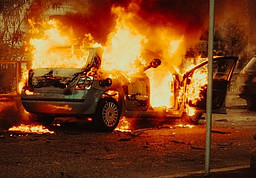
The greatest danger with cars is the risk of a fuel tank ignition – it could explode like a bomb, scattering burning gasoline everywhere. The aim is to control the fire before it can reach the tank. Everything has a flash point and a fuel tank is more at risk than most things. Usually a fuel line will catch fire first, acting as a fuse which eventually ignites the tank.
In A Garage
If a car catches fire in a confined space, such as a garage, smoke and toxic fumes will soon build up. Try to put the fire out first – but if that is not practical, remove the car from the building, before it further endangers life and property.
Do NOT get into the car. You can do everything from outside including steering. If possible, push or pull the car out. If your car has a button starter, select a low gear or reverse and use the starter to bounce the car out. With a conventional ignition, turn the key in short bursts. BE PREPARED – the car will jerk forward violently.
Other Situations
- In a crashed car: doors may jam. If it catches fire, get through any window or kick the windscreen out
- If the fire is inside the car: use an extinguisher (if available) or smother it with a rug or coat. Synthetic materials used in upholstery on many cars burn rapidly and give off thick smoke and toxic gases. These will persist even when the flames are out so get out into the fresh air as soon as possible.
- If the fire is also on the outside: amid spilled fuel, for example, keep the windows shut and drive out of the danger zone, abandoning the car as soon as it is safe to do so.
Fire Extinguishers
Fire extinguishers are very valuable pieces of prepper equipment. There are two basic type of extinguishers: those that use water and those that do not. Generally speaking, a non-water based extinguisher is recommended for most emergencies as water can actually make some fires even worse.
However, as with all tools, there are useless unless easily accessible. KEEP IT WHERE YOU CAN REACH IT! Don’t keep your extinguisher in the trunk – keep it in the passenger compartment where you can get at it immediately. Any impact could distort the trunk lid and prevent you from opening it.
To use a Fire Extinguisher properly:
- PULL – or otherwise to release any lock
- AIM – at the base of the fire
- SQUEEZE – or press the handle/trigger
- SWEEP – from side to side
As noted above, remember to check to see what kind of extinguisher you have. Some are designed for small, simple fires and contain water – they are NOT suitable for oil or electrical fires. Others are designed for oil, grease, paint or solvent fires. A third type is for electrical fires or those where live cables are exposed. A multi-purpose dry-chemical type extinguisher can be used on most kinds of fire.
Bottom line: KNOW HOW TO USE YOUR EXTINGUISHER!!